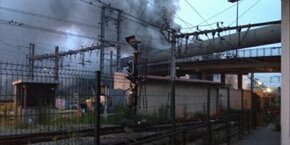Home > Other langages / Otros idiomas / Altri idiomi / Andere Sprachen... > In English > Strike where it hurts most !

Strike where it hurts most !
Sunday 8 December 2013
All the versions of this article: [Deutsch] [English] [français] [italiano]
Early in the morning of Wednesday 23rd a SNCF operational cabin went on fire in Vitry-sur-Seine. It’s not surprising because news of this kind can be often found in local tabloids. Technical incident, human error, overheating… or maybe arson. An action someone carried out for fun, maybe, or to give vent to their anger at one of the clogs of the world’s power machine, and not a minor one in this case! Maybe an action carried out on the spur of the moment, without planning it or knowing what was inside the cabin? Or an occurrence that would alarm railway operators and cops: the people who put fire knew very well what it was all about and its consequences?What we know about the fire comes from the press – that is to say the cops. And certainly the latter don’t like anyone to be too much interested in their business.As in the cabin there were machines that regulate railway traffic, its reactivation meant that the speed train lines serving the station of Austerlitz (near Vitry) had to be stopped; in fact there were no trains on Wednesday 23rd July and in part on the following day.
At the end of February 2013 there was a similar but much more incisive incident in Ville d’Avray. It was a fire (an accident, according to SNCF), which destroyed ‘electric and electronic equipment for manoeuvring, signalling and surveillance’ (Le Parisien). No train had circulated on the U line and on the first line for weeks.
But there are not operational cabins only… Major circulation problems occurred to TGV trains at the beginning of March 2012 in the region of Chambéry. In several spots (in the countryside) railway cables were burnt down (an action of sabotage in solidarity with NO TAV activists arrested in Italy). Those who have long memories remember the big mess at the Gare du Nord caused by a ‘small fire’ on a signalling switchbox in early 2008: about 300 underground and TGV trains bound to northern Europe remained still for hours.
What is interesting of these small incidents is that any material structure (for example the railway) has its weak points. An incident, be it provoked by accident or sabotage, can cause more or less serious consequences, according to where it occurs. All networks rely on particular points, and if these are put out of function very serious effects are produced over the entire network, they can even have a ‘domino effect’ (why not?)
The networks that keep the world going (transport of people, goods, energy and information) can be found everywhere, under our feet, over our heads, next to us, in drawers, in the open air, everywhere, and often far from the indiscreet eyes of cops and cameras.
To all those who can see…
[From : Lucioles n°18, August 2014.]
 Non Fides - Base de données anarchistes
Non Fides - Base de données anarchistes